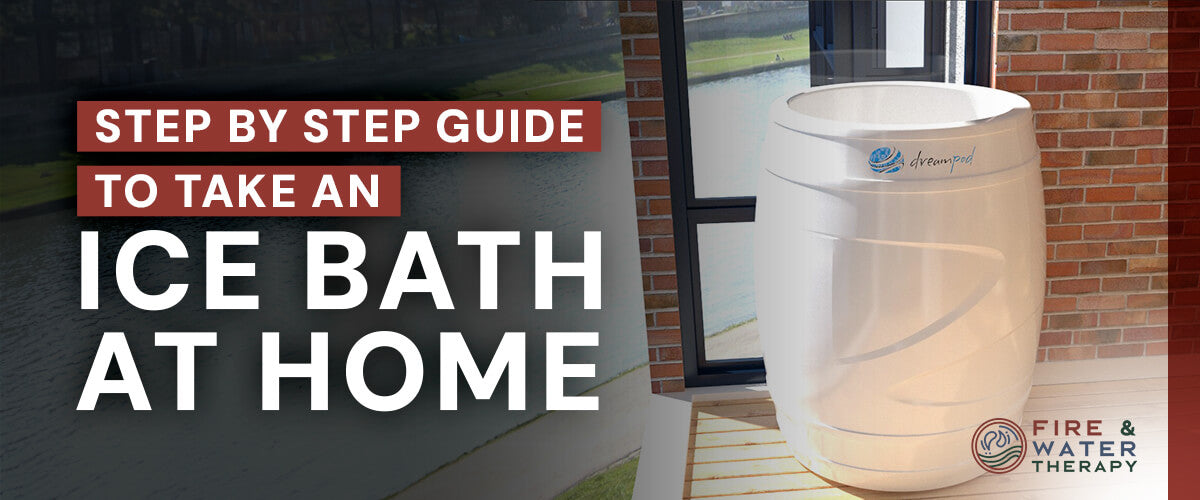Step By Step Guide to Take an Ice Bath at Home

Ice baths are best known for their recovery and relaxing benefits. But another best thing about it is that you can do it at home. You don’t need to go to facilities just to try it. However, you will need the right equipment and to follow the right procedures—you should know how to actually take one.
That’s why we have prepared a detailed guide about everything you need to know. Gain knowledge of the necessary arrangements needed, especially in terms of setup and equipment. Most importantly, find out the right steps to take for a proper ice bath at home. At the same time, we’ll also share some tips on how you can ensure safety while doing so.
What Are Ice Baths?

They are a type of cryotherapy in which a person immerses their body in extreme cold water. They are often referred to as cold water immersion or cold plunging as well. They are a well-liked method of cold water treatment, particularly favored by athletes. This is due to their ability to decrease inflammation, muscle soreness, and fatigue effectively. Aside from helping with recovery and relaxation, they also offer the following benefits:
- Helps improve sleep
- Provide stress relief
- Cools the body down
- Boost mood
- Strengthen the immune system
When to Take Them?
Ice baths are regularly taken after these activities and situations:
- After a Workout
Cold temperatures are considered excellent analgesics—painkillers. The cold can reduce the speed of nerve conduction, muscle soreness, and more. This is why ice baths are practiced by many athletes after intense workouts. It also helps reduce the likelihood of delayed-onset muscle soreness (DOMS).
- After an Injury
There’s a good reason why injured people are usually treated with a cold compress to prevent worsening the situation. Cold temperatures, like those in ice baths, help in reducing blood flow to the area of injury, or where there’s muscle damage. This results in a decrease in swelling and inflammation of that part.
- After a Sauna
Briefly getting into cold water after a sauna session can bring many benefits. It can help improve your circulation, strengthen your blood vessels, and contribute to enhancing your immune system.
Of course, you can also take a bath even when you’re not from a workout, a sauna session, or injured. You can try it even if you want to simply enjoy its benefits and as a form of meditation.
Preparation Needed for Ice Baths
Before anything else, you have to make the necessary preparations to ensure a smooth session. Here are the key steps you should take to prepare:
Check With Your Doctor
Before using cold therapy like this to recover and relax, you have to make sure that your health won’t be negatively affected by it. This is extremely important if you have any underlying health condition. Talk to your doctor and inform them why you want to try it. Ask whether you can proceed considering the health condition you have. Generally, it’s not ideal for people with the following health conditions:
- High blood pressure
- Venous stasis
- Heart disease
- Diabetes
- Skin injuries
- Peripheral neuropathy
- Any cold-related disease, and more
Prepare Your Equipment
Generally, you’ll have to gather and set up the following items and equipment:
- Plunge tub/Bathtub
- Thermometer
- Ice (Optional)
- Timer
- Towels
Take note that the ice is optional since there are plunge tubs you can use that can extremely lower the temperature of the water you’ll use. Depending on the coldness you can tolerate, you might not need ice. If you’re using one like that, you might need a hose as well.
Set Up Everything
Place your tub and other equipment in the place you want to do it, whether indoors or outdoors. Make sure to place the timer near the tub so you can keep track of the time. At the same time, it’s best to prepare some change of clothes and towels and place them nearby as well. This will help after your session.
6 Easy Steps in Taking an Ice Bath at Home

After doing the necessary preparations, it’s finally time to take a bath. Here’s a step-by-step procedure to follow to ensure a smooth session:
Fill the Bath With Water
Fill your bathtub or plunge tub with cold water. Make sure to not fill it all the way; halfway would be enough. This is because you will still have to add ice, which will add volume. Plus, once you get into the tub, the water will rise once more.
Add Ice and Check the Temperature
If the coldness of the water isn’t enough for you, add ice to the water. Do it gradually so as to not exceed your preferred temperature. You can start with one kilogram of ice and then add more to reach that temperature. Use a thermometer to monitor the temperature. If you’re a beginner, it’s okay to start at around 60°F. You can simply work your way down as you gain more experience with the cold.
Set Your Timer
Decide how long you want to stay in the water. You can use your phone or a separate timer to set it. You can start with 5 to 10 minutes—complete beginners can start for a shorter time. Make sure not to stay in the bath for more than 15 minutes. But, you can increase the time as you get more comfortable with the cold later on.
Get In Slowly
Don’t just jump in the tub of ice-cold water. The extreme cold can jolt you and cause shock to your body. So, slowly and gradually lower yourself into the water. Start with your feet, then your legs, and then your waist. Do it up until you’re submerged up to your chest and neck. Make sure to keep your head above the water. At the same time, don’t forget to relax as you get in. The coldness can make you nervous. To avoid that, take deep and slow breaths. Plus, make sure to start your timer after entering the bath.
Relax in the Water
Stay in the tub for about 5 minutes, or the time you decided to stay in beforehand. Simply sit back in the tub and continue taking slow, deep breaths to draw in air deep into your lungs. You can also count your breaths. This is to relieve any tension in your body. You can also distract yourself with some light reading or music. Still, don’t forget to keep an eye on your timer.
Get Out and Warm Up
Once the time is up, get out of the tub slowly. Don’t try to move in a hurry as you might slip because of the water. Then, dry yourself with the towel you prepared beforehand and remove your wet clothes. Put on a warm change of clothes to help warm up your body again. You can also consider drinking some warm tea afterward.
Essential Tips to Remember When Taking Ice Baths
Taking ice baths may sound extremely simple but there are a lot of considerations to make. This is to ensure that you get the intended benefits of the therapy and not hurt yourself. Here are some valuable tips to remember:
- Take a Cold Shower First
You can prepare yourself mentally and physically for the cold with a cold shower. Do it for one to three minutes. This will help you gauge how your body will react—pay attention to how it responds to the cold water. You can also practice breathing as the shower continues and notice any signs of panic and tension.
- Learn Breathing Techniques
Breathing techniques can help you handle the cold more easily. They can help you stay calm and control the shock response of your body to the cold water. There’s a wide variety of techniques you can use before, during, and after a session.
- Wear Appropriate Clothing
You need to wear pieces of clothing before you get into the icy cold water. Otherwise, your body can be damaged, especially if you have sensitive skin. Wear protective clothing to cover your feet and genitals. You can wear shorts, swimming trunks, and socks or booties. If you think the upper half of your body is sensitive, you can also wear a shirt to protect your skin and keep you from freezing.
- Hydrate Yourself
Make sure to drink water before you get into the tub to stay hydrated. Keep in mind that cold exposure like this can be dehydrating, which can also influence the shock you’ll experience. By staying hydrated, your body will be able to cope better with the temperature shock.
Conclusion
Ice baths can enhance the overall health and well-being of individuals through various means. If you want to give it a shot, you simply need to ensure that you are doing it correctly—safely and effectively. By doing this, you can prevent injury and fully appreciate each session.
If you’re still searching for equipment and accessories to use, you can visit our ice bath collection. We offer a wide range of quality tubs and other related products you can utilize for a comfortable and safe cold water immersion experience!




